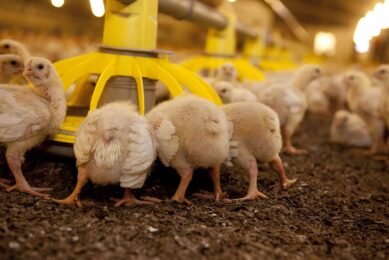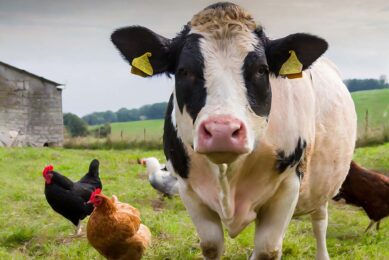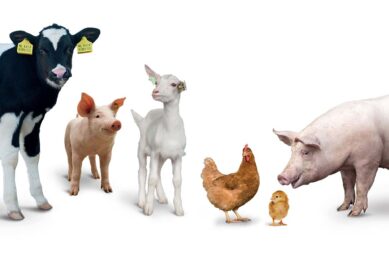Demedication inspired by nature…CCPA’s way

CCPA nutritionists unearth forgotten natural ingredients to pave the way for antibiotic reduction.
Mickael Huffman of the University of Kyoto demonstrated 20 years ago that 22% of what wild chimpanzees eat has no strict nutritional action but pharmacological effects induced by secondary metabolites of the plants consumed. Wild animals can select plants with antispasmodic effect when they experience gastrointestinal pain, sexual stimulating plants during reproduction periods or even anxiolytic when they feel stressed. You might think that this ability only concern evolved animals like primates, it’s wrong. Insects are also able to utilise the chemical defences of plants to protect themselves from their own predators or parasites. Centuries of co-evolution of plants and animals has led to complementary strategies to maintain the homeostasis, essential balance to keep animals healthy.
Adjusted feeding behaviour
In face of these centuries of co-evolution that led nature to retain best “health solutions”, has the recent but intense genetic selection altered these capacities in farm animals? The answer is no. Several research demonstrated that ruminants with a high burden of gastrointestinal parasites, when given the opportunity to do so, change their feeding behaviour, looking for plants in height – devoid of infesting larvae – richer in tannins. Tannins are known for their anti-parasitic role. This behaviour is maintained if their parasite burden is high. Chickens are also able to choose plants secondary metabolites depending on their physiological status. In a recent publication a team of INRAE demonstrated that chicks can make spontaneous choices of essential oils according to their postnatal experience. Stressed chicks spontaneously consume more verbena than the “non stressed” control group which prefers clear water. The main components of verbena’s essential oil (geranial, neral and limonene) are known for their anxiolytic and sedative effects. Pigs and wild boars are also able to select specific roots known for their anthelminthic effects.
Plant-based diet
If we have a look at natural diets of livestock species, it becomes obvious that plants secondary metabolites are an essential part of their nutrition. Wild ruminants consume between 50 and 70 plant species per day, while we offer them between 4 and 6 in farm conditions. The diet of feral pigs or wild boars is more than 90% plant-based. It is mainly composed of plants material with an extraordinary variety: bulbs, roots, tubers, wood, bark, seeds, herbs, grass, leaves, nuts and various fruits. The diet of the red junglefowl, our domestic chicken ancestor has the same diversity.
Forgotten ingredients
What are these plants secondary metabolites (PSM) and how do they benefit animals? PSM belongs to a wide variety of chemicals: phenols, terpenes, flavonoids, tannins. All are active molecules for plants: defence from microorganisms (viruses, bacteria, protozoans), defence from herbivores, attraction of pollinators (insects, birds, bats) and cells protection against UV. When consumed by animals, they demonstrate pharmacological activities mainly focused on cell protection, immunomodulation, microbiota modulation and at higher dose biocide effects. Their anti-inflammatory, antioxidant, antimicrobial activities are now well documented. Like vitamins and trace elements, they contribute to the homeostatic balance and therefore to the maintenance of a good state of health (Figure 1). Besides, early researchers like Albert Szent-Györgyi (Nobel prize for the discover of vitamin C) proposed that flavonoids should be considered as vitamins. While nutritionists have considered the need for vitamins and trace elements in feed formulas for farm animals, how could we have forgotten these essential ingredients?
Figure 1- Relative expression of cell protection associated transcription factor (Nrf-2) in addition of plant secondary metabolite (PSM) on mammary epithelial cells.

Plant extracts and essential oils
In fact, when distributed to healthy animal at inappropriate level, most of the PSMs have so called “antinutritional” activities. They can reduce digestibility, some of them, because of their bitter taste, can decrease feed intake and at higher doses they become toxic. Furthermore, if we only focussed on nutritional requirements of healthy animals in healthy situations, PSMs distributed at high doses can reduce the growth and production of farm animals.
The success of antibiotics in livestock production has probably something to do with the fact that we did not consider the need for these specific nutrients that are PSMs in livestock diets. In the 2000s, a lot of research on antibiotics used in animal production showed that, in addition to their antibacterial effects, they also had anti-inflammatory effects… like PSMs. In facts, antibiotics probably took the place that PSMs have in “natural nutrition”. Since then, working on plants parts providing PSMs or plant extracts and essential oils that concentrate them, has become an essential part of livestock nutrition research and diet formulation. Fred Provenza (professor emeritus of Behavioural Ecology at Utah State University) summarises this evolution as follows “The challenge of feeding systems is incorporating mixes of plants with bioactive properties in ways that enhance health and welfare without compromising production.”
CCPA anticipated this challenge more than 20 years ago, working in three complementary directions:
- Measure the biological activities of plants to screen plants and synergic associations of plants
- Characterise plants and their composition to ensure stable effects
- Evaluate in vivo the health, welfare and production benefits for livestock animals and farmers
We develop in vitro test to evaluate antimicrobial activities of PSMs and their effects on gut microbiota. Anti-inflammatory and antioxidant activities are screened with specific cells models (Figure 2).
Figure 2 – In vitro inflammation marker (TNF α) expression under pro inflammatory condition (LPS model) with addition of standardised plant extracts (10 mg/ml). CCPA and Rennes 1 University.

Inspired by nature
Working with the department of Hormonal and Nutritional Biochemistry of Grenoble Hospital and Dr Michel Brack, oxidative stress specialist, we developed the first oxidative stress diagnostic tool adapted to farm animals. Each year, around 20 in vivo trials are done in our research station Euronutrition or in collaboration with international research teams to define nutritional requirements for plants secondary metabolites in pigs, poultry and ruminants, as we do for all classical nutrients. Even if there is still a lot of research to do, this strategy inspired by nature turns out to be a success in many phases of breeding in reducing or stopping preventive use of antibiotics.
References available on request.
Author:
Fabrice Robert, DVM, CCPA Group R&D Manager







